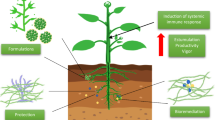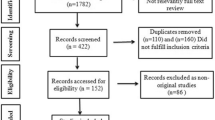Abstract
The influence of autoclaved fungal materials such as culture filtrate, freeze-dried mycelium (FDM), mycelium suspension, and spore suspension (SS) on the growth, morphogenesis, and carvone production of spearmint (Mentha spicata L.) plants was studied. Fungal materials were either applied as a drench or spray on the plants. Spearmint plants (cv. “294099”) drenched with SS (1 × 108 spores/ml) of Trichoderma reesei showed no significant differences in leaf numbers, root numbers, or shoot numbers compared with nontreated controls. However, significantly higher fresh weights and carvone levels were observed in plants drenched with T. reesei SS compared with the untreated controls. Fungal materials derived from Aspergillus sp., Fusarium graminearum, F. sporotrichoides, Penicillium sp., P. acculeatum, Rhizopus oryzae, and T. reesei were sprayed on spearmint foliage. F. graminearum, F. sporotrichoides, or R. oryzae elicited no enhanced growth, morphogenesis, or secondary metabolism responses. The best growth and morphogenesis responses were obtained employing Aspergillus sp., Penicillium sp., or T. reesei foliar sprays. For example, spearmint cv. “557807” plants sprayed with 100 mg/l FDM T. reesei isolate NRRL 11460 C30 stimulated higher fresh weights (75%), shoot numbers (39%), leaf numbers (57%), and root numbers (108%) compared with untreated plants. This effect was not dose-dependent because similar growth and morphogenesis responses were obtained by testing 10, 100, or 1000 mg/l FDM concentrations. Carvone levels in fungal-treated foliar-sprayed plants were comparable to nontreated controls. However, total carvone levels per plant were higher in fungal-treated plants because of their increased fresh weight.






Similar content being viewed by others
References
M. J. Anderson J. L. Brookman D. W. Denning (2002) Aspergillus R. A. Prade H. J. Bohnert (Eds) Genomics of Plants and Fungi Marcel Dekker Inc. New York 1–39
F. A. Bazzaz N. R. Chiariello P. D. Coley L. F. Pitelka (1987) ArticleTitleAllocating resources to reproduction and defense BioScience 37 58–67
E. A. Bell (1981) The physiological role(s) of secondary (natural) products E. E. Conn (Eds) Biochemistry of Plants Academic New York 1–19
A. A. Brakhage J. Bernhard (2002) Molecular mechanisms of pathogenicity of Aspergillus fumigatus H. D. Osceiwacz (Eds) Molecular Biology of Fungal Development Marcel Dekker Inc. New York 559–582
Y. C. Chang Y. C. Chang R. Baker (1986) ArticleTitleIncreased growth of plants in the presence of biological control agent Trichoderma harzianum Plant Dis. 70 145–148
F. S. Chapin SuffixIII (1991) ArticleTitleIntegrated responses of plants to stress BioScience 41 29–36
F. S. Chapin SuffixIII E. D. Shulze H. A. Mooney (1990) ArticleTitleThe ecology and economics of storage in plants Annu. Rev. Ecol. 21 423–447
A. R. M. Chen P. B. Reese (2002) ArticleTitleBiotransformation of terpenes from Stemodia maritima by Aspergillus sp. ATCC 9142 Phytochemistry 59 57–62 Occurrence Handle1:CAS:528:DC%2BD3MXpt1aitLc%3D Occurrence Handle11754944
C. Cheniclet C. Bernard-Dagan G. Pauly (1988) Terpene biosynthesis under pathological conditions W. J. Mattson J. Levieux C. Bernard-Dagan (Eds) Mechanisms of Woody Plant Defenses Against Insects: Search for Pattern Springer-Verlag Berlin Heidelberg, New York 117–130
K. Dalkin R. Edwards B. Edington R. A. Dixon (1990) ArticleTitleStress responses in alfalfa (Medicago sativa L.). I. Induction of phenylpropanoid biosynthesis and hydrolytic enzymes in elicitor-treated cell suspension cultures J. Plant Physiol. 92 440–446 Occurrence Handle1:CAS:528:DyaK3cXktlOrsLk%3D
R. E. Dickson J. G. Isebrands (1991) Leaves as regulators of stress response H. A. Mooney W. E. Winner E. J. Pell (Eds) Integrated Response of Plants to Multiple Stresses Academic New York 3–34
R. A. Dixon C. J. Lamb (1990) ArticleTitleMolecular communication in interaction between plants and microbial defense in plants Adv. Genet. 28 165–234 Occurrence Handle1:CAS:528:DyaK3MXpsFylug%3D%3D Occurrence Handle2239449
U. Eilert F. Contabel (1986) ArticleTitleElicitation of sanguinarine accumulation in Papaver somniferum cells by fungal homogenates—an induction process J. Plant Physiol. 125 167–172 Occurrence Handle1:CAS:528:DyaL28XmtVKgtr4%3D
U. Eilert F. Constable W. G. W. Kurz (1986) ArticleTitleElicitor-stimulation of monoterpene indole alkaloid formation in suspension cultures of Catharanthus roseus J. Plant Physiol. 126 11–22 Occurrence Handle1:CAS:528:DyaL2sXpvFGksQ%3D%3D
Y. Elad (2000) ArticleTitleBiological control of foliar pathogens by means of Trichoderma harzianum and potential modes of action Crop Prot. 19 709–714
S. L. Gulmon H. A. Mooney (1986) Costs of defense and their effects on plant productivity T. J. Givinish (Eds) On the Economy of Plant Form and Function Cambridge University Press Cambridge 681–698
P. Heinstein (1985) ArticleTitleFuture approaches to the formation of secondary natural products in plant cell suspension cultures J. Nat. Prod. 48 1–9 Occurrence Handle1:CAS:528:DyaL2MXitF2mtrg%3D
J. Kuc (1997) ArticleTitleMolecular aspects of plant responses to pathogen Acta Physiol. Plant. 19 551–559 Occurrence Handle1:CAS:528:DyaK1cXitleitbk%3D
H. Lambers A. M. Rychter (1990) The biochemical background of variation in respiration rate: Respiratory pathways and chemical composition H. Lambers M. L. Cambridge H. Konings T. L. Pons (Eds) Causes and Sequences of Variation in Growth Rate and Productivity of Higher Plants SPB Academic Publishing The Hague 199–225
A. Y. Leung (1980) Encyclopedia of Common Natural Ingredients Used in Food, Drugs and Cosmetics John Wiley and Sons New York
G. B. Mahady C. W. W. Beecher (1994) ArticleTitleElicitor-stimulated benzophenanthridine alkaloid biosynthesis in bloodroot suspension culture is mediated by calcium Phytochemistry 37 415–419 Occurrence Handle1:CAS:528:DyaK2cXmsFWns7k%3D
U. Margna E. Margna T. Vainjärv (1989) ArticleTitleInfluence of nitrogen nutrition on the utilization of l-phenylalanine for building flavonoids in buckwheat seedling tissues J. Plant Physiol. 134 697–702 Occurrence Handle1:CAS:528:DyaL1MXlsFaksLs%3D
S. N. Raj G. Chaluvaraju K. N. Amruthesh H. S. Shetty M. S. Reddy J.W. Kloepper (2003) ArticleTitleInduction of growth promotion and resistance against downy mildew on pearl millet (Pennisetum glaucum) by rhizobacteria Plant Dis. 87 380–384
C. M. Ryu M. S. Reddy S. Zhang J. F. Murphy J. W. Kloepper (1999) ArticleTitlePlant growth promotion of tomato by a biological preparation (LS213) evaluation for protection against cucumber mosaic virus Phytopathology 89 S67
H. Toyama N. Yamagishi N. Toyama (2002) ArticleTitleConstruction of cellulase hyper-producers of Trichoderma reesei Rut C-30 for utilization of waste paper using colchicines and benomyl J. Mol. Catal., B Enzym. 17 175–178
K. Williams F. Percival J. Merino H. A. Mooney (1987) ArticleTitleEstimation of tissue construction cost from heat of combustion and organic nitrogen content Plant Cell Environ. 10 725–734 Occurrence Handle1:CAS:528:DyaL1cXhsVKlt70%3D
G. W. Zehnder C. Yao J. F. Murphy E. R. Sikora J. W. Kloepper (2000) ArticleTitleInduction of resistance in tomato against cucumber mosaic cucumovirus by plant growth-promoting rhizobacteria BioControl 45 127–137
Acknowledgments
This study was partially funded by Biotechnology and Research Development Company, Peoria, IL. The authors wish to thank R. K. Holloway for technical assistance.
Author information
Authors and Affiliations
Corresponding author
Additional information
Names are necessary to report factually on available data; however, the USDA neither guarantees nor warrants the standard of the product, and the use of the name by USDA implies no approval of the product to the exclusion of others that may also be suitable.
Rights and permissions
About this article
Cite this article
Khan, N.I., Tisserat, B., Berhow, M. et al. Influence of Autoclaved Fungal Materials on Spearmint (Mentha spicata L.) Growth, Morphogenesis, and Secondary Metabolism. J Chem Ecol 31, 1579–1593 (2005). https://doi.org/10.1007/s10886-005-5799-7
Received:
Revised:
Accepted:
Published:
Issue Date:
DOI: https://doi.org/10.1007/s10886-005-5799-7




